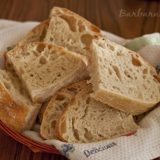Coccodrillo Bread Recipe
Servings: 2 loaves
Ingredients
First starter:
- ½ teaspoon active dry yeast or ⅙ small cake 3 grams fresh yeast
- 1 cup warm water
- ¼ cup 35 grams durum flour
- ¾ cup 90 grams unbleached stone-ground flour* (*use strong bread flour -stone ground or not- for a better result)
Second starter:
- 1 ¼ teaspoons active dry yeast or ½ small cake 9 grams fresh yeast
- ¼ cup warm water
- 1 ¼ cups water room temperature
- ½ cup 70 grams durum flour
- 1 ½ cups 180 grams unbleached stone-ground flour (use strong bread flour -stone ground or not- for a better result)
Dough
- ¼ cup 35 grams durum flour
- 1 to 1 ¼ cups 120 to 140 grams unbleached stone-ground flour (use strong bread flour -stone ground or not- for a better result)
- 1 ½ teaspoons 10-15 grams salt* (*it says 25 g in the book, but this will get you a very, very salty crocodile)
Instructions
First starter:
- The morning of the first day, stir the yeast into the water; let stand until creamy, about 10 minutes.
- Add the flours and stir with a wooden spoon about 50 strokes or with the paddle of an electric mixer about 30 seconds.
- Cover with plastic wrap and let rise 12 to 24 hours. The starter should be bubbly.
Second starter:
- The evening of the same day or the next morning, stir the yeast into the warm water; let stand until creamy, about 10 minutes.
- Add the water, flours and dissolved yeast to the first starter and stir, using a spatula or wooden spoon or the paddle of the electric mixer until smooth.
- Cover with plastic wrap and let rise 12 to 24 hours.
- Dough
- By mixer: The next day, add the durum flour and 1 cup unbleached flour to the starter in a mixer bowl; mix with the paddle on the lowest speed for 17 minutes. Add the salt and mix 3 minutes longer, adding the remaining flour if needed for the dough to come together. You may need to turn the mixer off once or twice to keep it from overheating.
- By hand: If you decide to make this dough by hand, place the starter, durum flour, and 1 cup unbleached flour in a wide mouthed bowl. Stir with a rubber spatula or wooden spoon for 25 to 30 minutes; then add the salt and remaining flour if needed and stir 5 minutes longer. The dough is very wet and will not be kneaded.
- First Rise: Pour the dough into a Hammarplast bowl or a wide mouthed large bowl placed on an open trivet on legs or on a wok ring so that air can circulate all around it. Loosely drape a towel over the top and let rise at about 70° F, turning the dough over in the bowl every hour, until just about tripled, 4 or 5 hours.
- Shaping and Second Rise: Pour the wet dough onto a generously floured surface. Have a mound of flour nearby to flour your hands, the top of the oozy dough, and the work surface itself. This will all work fine-appearances to the contrary-but be prepared for an unusually wet dough. Make a big round shape of it by just folding and tucking the edges under a bit. Please don't try to shape it precisely; it's a hopeless task and quite unnecessary. Place the dough on well, floured parchment or brown paper placed on a baking sheet or peel. Cover with a dampened towel and let rise until very blistered and full of air bubbles, about 45 minutes. (Here's a video showing how to shape the super wet dough.)
- Baking: Thirty minutes before baking, heat the oven with a baking stone in it to 475° F. Just before baking, cut the dough in half down the center with a dough scraper; a knife would tear the dough. Gently slide the 2 pieces apart and turn so that the cut surfaces face upward. Sprinkle the stone with cornmeal. If you feel brave, slide the paper with the dough on it onto the stone, but the dough can also be baked directly on the baking sheet. When the dough has set, slide the paper out. Bake for about 30 to 35 minutes. Cool on a rack.
